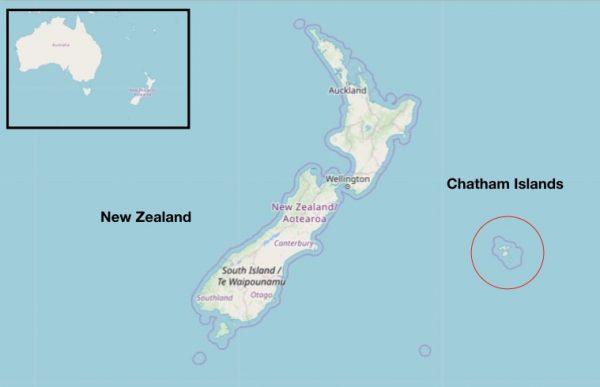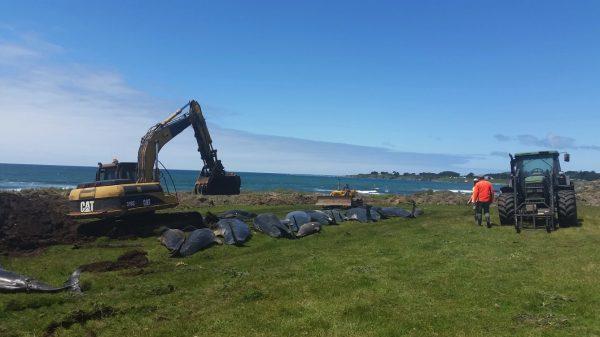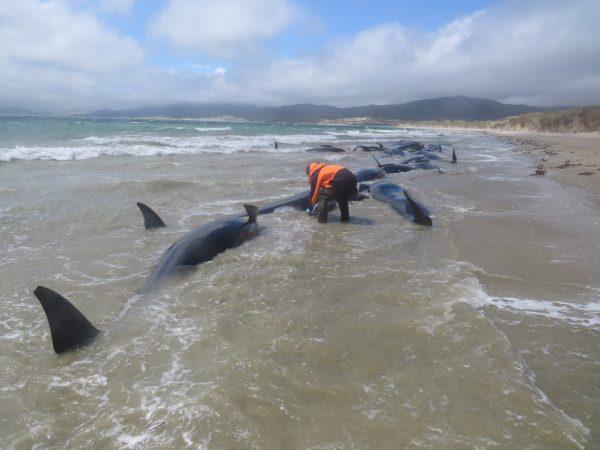Fifty-one pilot whales have died after becoming stranded on a beach on the Chatham Islands off New Zealand.
The demise of the whales brings the total, in separate incidents over the past week in the region, up to around 200 deaths.

Several dozen whales managed to refloat themselves but 50 were found dead. Conservation officials said they were forced to put one of the whales down.
“There was no likelihood of being able to successfully save the remaining whale. Sadly, the decision was made to euthanize. It was the most humane thing to do,” said the DOC’s Chatham Islands Operations Manager, Dave Carlton.
“This is always an awful decision to have to make.”

Officials said they are working closely with local Maori communities to arrange for the handling of the whales.
Workers used heavy equipment to dig a mass grave to bury the 51 whales. DOC officials explained they had to bury the whales at that location away from the beach, because it was not possible to bury them in the sand.
Officials said skin and blubber samples were being taken for analysis.
The remote and sparsely populated Chatham Islands are about 500 miles off the east coast of New Zealand’s South Island.
The deaths there come less than a week after 145 pilot whales became stranded on a remote beach in New Zealand’s far south Stewart Island, and either died naturally or were euthanized.

According to DOC Rakiura Operations Manager Ren Leppens, half of the whales had already died by the time they were found.
‘Heart-Breaking Decision’
Leppens said in a statement, “Sadly, the likelihood of being able to successfully refloat the remaining whales was extremely low.“The remote location, lack of nearby personnel and the whales’ deteriorating condition meant the most humane thing to do was to euthanize.
“However, it’s always a heart-breaking decision to make.”
Mass Strandings in New Zealand
New Zealand has more recorded strandings than almost any other part of the world. The stranded marine mammals are typically long-finned pilot whales.Although marine mammal strandings are “relatively common” in New Zealand, with around 80-85 incidents a year, they are mostly of single animals, according to the DOC.
Herd Behavior
Pilot whales are one of the most populous whale species. They get their name from the way they travel in pods: One male leads the way as a “pilot” with the rest of the pod of up to 200 whales following.They show very strong herd behavior.
The tight social cohesion and “pilot” behavior could be an important factor in stranding, and then re-stranding after being rescued and refloated, according to some researchers.
However, the reason for strandings of whales and dolphins is not fully understood, said the DOC. Possible reasons include: Sickness, navigational error, geographical features, a rapidly falling tide, being chased by a predator, or extreme weather.
Some conservation campaigners have suggested high-intensity sound waves from oil and gas exploration, and the use of naval ship sonar could also be interfering in the animals’ navigation systems.
However, conservation officials note that these should not be confused with natural whale traps, such as the one at Farewell Spit, where whale strandings have been noted for centuries.
In the video below, Dr. Dave Lundquist, DOC’s Technical Advisor for Marine Species and Threats, discusses the series of whale strandings that have taken place in New Zealand during Nov. 2018.
The largest recorded stranding of pilot whales was back in 1918, when over 1,000 were trapped on the shores of Chatham Islands.




